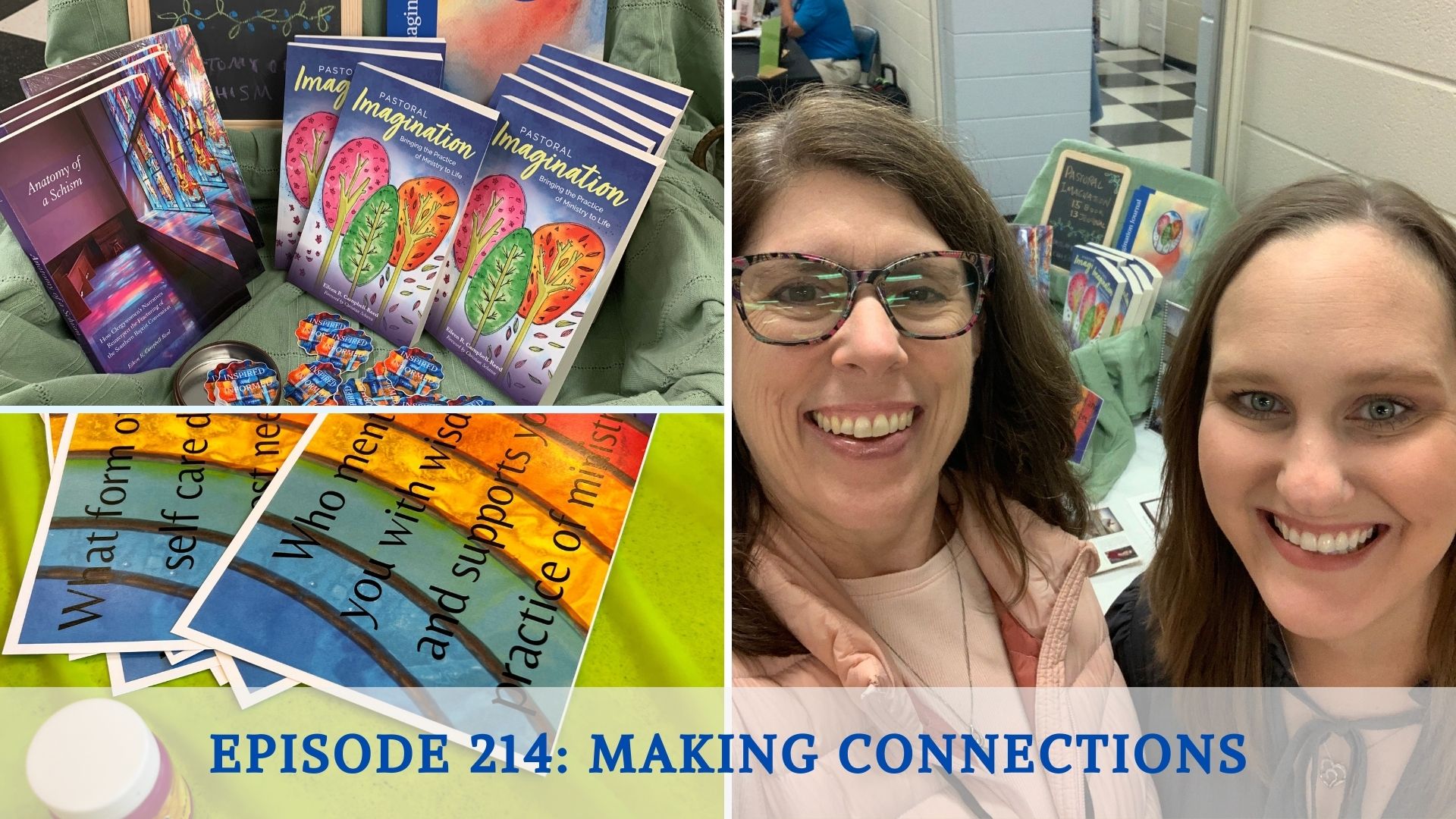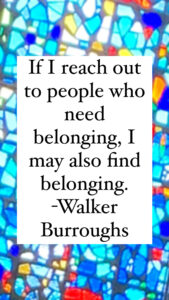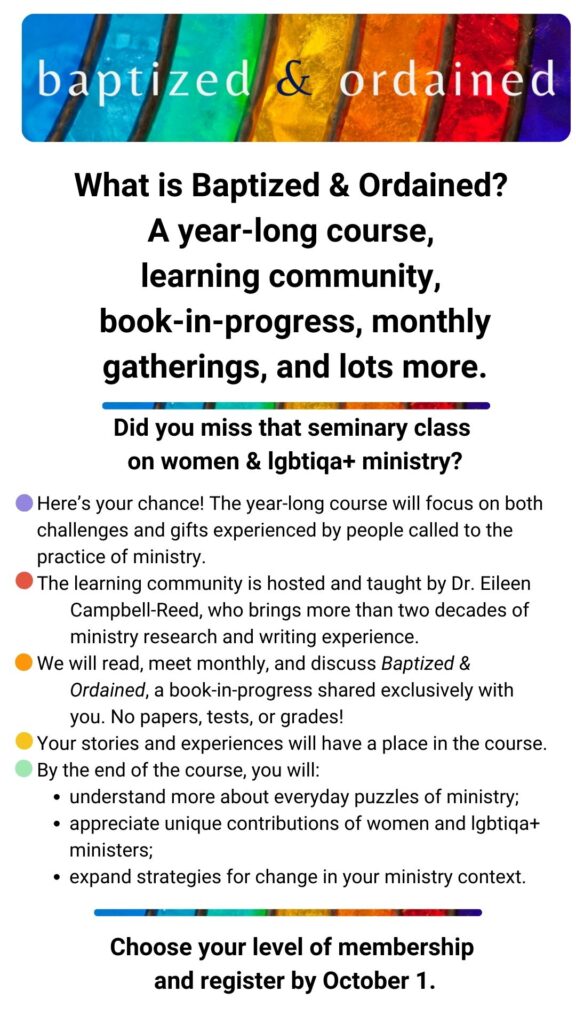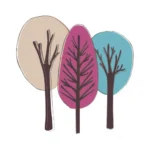This weekend I spent time renewing and making new connections with Baptist friends. As an extrovert I found this mostly energizing. I know it’s not everyone’s idea of fun. And maybe you would rather make connections with one person over many cups of coffee than in a room full of people each holding their one cup!
If you’ve been taking part in our conversation here at Three Minute Ministry Mentor for any time at all, you know that “ministry is relational” is a resounding theme. We don’t learn how to do the work of ministry by simply thinking about it. Humans learn and know and grow by body and relationships. We need spiritual engagement and on-the-ground practice that integrates knowledge, skills, and identity. Our identities as people of faith and pastoral leaders of congregations and spiritual care, emerge through and with the relationships we take time to nourish and nurture.
In other words, making connections is a key component of learning and leading in ministry.
This weekend one of Nashville’s wise and wonderful teachers and storytellers, Dr. Judy Skeen, wove together stories and people and questions and songs. She helped us share meals around tables to create a gathering that was so much more than just another Baptist meeting. These connections look like just what many people needed.
Connecting in a new era of ministry
As I’ve been making a case for the last year, church and ministry are changed and changing. Digital ministry is here to stay. No amount of retreating from hybrid or digital engagements will be possible anytime soon. Yet we are still new at those engagements, and we need the familiar, in-person connections when possible. Standing in the same room, sitting on the same pew, singing in harmony, sharing stories and listening with our full selves. These moments connect us richly with each other.
We can and are learning how to do the work of connecting in the digital world. And we will get better at our digital connections. Right now many people remain hungry for connecting in person.
At least some of the deeply felt need to make human connections is for me (and I think for many of us) related to the losses of the last few years of pandemic measures since March 2020.
Connecting to people in grief
Also this weekend, I decided to go ahead and be the last person in the country to watch the 2009 movie UP!
In the 14 years since UP hit the big screen, I’ve repeatedly heard people say, “That movie makes me cry every time.“ This didn’t really concern me. (And I love a good Pete Docter movie.) I believed that somehow I needed to be prepared for it, you know, before starting the movie. But as you may already know, preparing for loss and grief is nearly impossible. There is no controlling when grief shows up. And rarely can we even anticipate it. Grief comes when it comes.
If you do happen to be among the small number of people who still haven’t yet watched UP, I will not spoil it for you. I will say that it is both delightful and insightful. The movie explores the experience of grief in a beautiful and creative way.
Grief is often a piece of the primary work of pastoral ministry. Loss and grief have many emotional faces, and if one is going to lead a religious or spiritual community, or work for justice and change, grief will certainly be part of the leadership story.
I may not have watched the movie UP, 14 years ago. However, I’ve written about grief extensively in this blog over that time. And recently I wrote about, “The Spiritual Work of Honoring our Losses and Grief ” for the Moses Project.
Loss and grief can land nearby at any time. And most anything can trigger my experiences of loss and feelings of grief. What about you? We can also suddenly be dropped into our grief even when we fail to recognize what has been triggered. You know the times… we try distracting ourselves, jumping up and down in anger at the wrong things, or feeling hounded by fear and other misplaced feelings. We can also miss out on listening or even noticing the people around us who are trying to connect.
Grief as a Form of Connection
Here’s the thing. When it comes right down to it, grief is another form of connection.
We long for the forms of connection that include embodied presence and laughter and touch and shared experiences. Yet as many artists and poets and theologians have pointed out grief is the underside of love. That means it’s yet another way to be connected even beyond the ruptures of separation and death. We carry our love and the persons and experiences that we loved with us beyond the loss, which is not to pretty it up at all. But when we reframe grief as a new (and challenging) form of connection, it can help us shift the intensity of emotion and point us toward rituals that help us remember and connect in new ways. As Mr. Fredrickson would say, we might even try out a new adventure.
Connecting through Writing
One of my joys at being in person with Baptist folk this weekend was talking to long-time friends like Colleen Burroughs. She and I met so many years ago before she even started seminary, and I had only one semester under my belt. We both worked for Woman’s Missionary Union in the days when that was still something safe and even cool to do. She was here in Nashville this weekend to support her beloved and talented singer-songwriter son, Walker Burroughs.
And I met people and made connections that I can imagine becoming part of my growing rich network of collaboration and conversation. The books I’ve written give me an easy way to connect with ministers and lay leaders. For instance, I appreciated the Sunday school teacher who wanted to use Pastoral Imagination with her 40-something couple Sunday school class. And I assured her that I’ve heard from quite a few school classes who found the book helpful and engaging.
I also loved meeting the leader who wanted to buy Anatomy of a Schism for her church’s youth minister. She’s doing what she can to support a clergywoman. I love being part of that extension of support and connection. And I loved meeting writers and editors who wanted to learn more about the Writing Table. And people who support and mentor pastors who want to know more about what we’re learning through the LPI Project.
I did not write Pastoral Imagination so that people could say, “Oh look at everything you know!” Rather, I wrote it to share stories and questions that invite and facilitate conversations between and among faith leaders. I wrote it for YOU! Lay people and clergy, seminarians and seasoned pastors who are all continuing to learn how to practice ministry. We need each other, and we need to connect. Books are one of the ways we do that.
The relational connections we need to learn and grow
One of the things that became abundantly clear early in a longitudinal study of ministry is that learning in practice has features that cut across many different domains of life. Being a novice and then becoming skilled enough and knowledgeable enough to try out a new practice, the need for mentors and feedback, the necessity of taking risk and responsibility for one’s actions, learning from the ‘aha’ moments that stick with us.
These aspects of learning in practice are common across many different practices from sports and music to cooking and driving. It is so valuable to know and understand this framework of adult human learning. We are better prepared when we know where to look for the potholes and tripwires. Then we learn not only through our own mistakes and failures, but also from our connections with each other. The best learning in practice is relationally connected and supported, and it takes the long view.
How are you nurturing the connections in your life and ministry? Maybe you are also ready for a new adventure? What can you do this week to reach out with a story or song or cup of coffee? Connect with a text or phone call or email?
When you do, you are adding a strand of connection into your support network. The network not only supports you, but also everyone else who is a part of it. As Walker Burroughs says, “If I reach out to people who need belonging, I may also find belonging.“
Baptized and Ordained
Making more connections! We are gathering now for an October start to the new course, learning community, and book-in-progress! If you want to learn alongside a community about how ministry has been both gift and challenge for women and lgbtiqa+ people, I hope you will join us! In the Baptized & Ordained gatherings we will consider the history, cultural conditions, and brick walls inside the church itself. And we will also consider how clergywomen and lgbtiqa+ ministers are changing the practice of ministry for the better! Join me in the new Baptized & Ordained course and community. Let’s learn together.
Choose your membership level and join by October 1.






